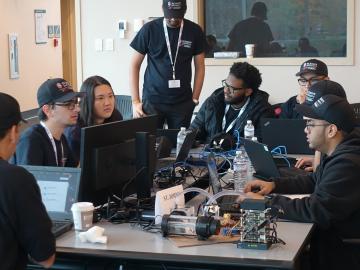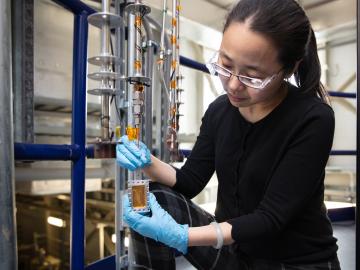
Filter News
Area of Research
- (-) National Security (39)
- (-) Neutron Science (46)
- Advanced Manufacturing (21)
- Biological Systems (1)
- Biology and Environment (36)
- Building Technologies (1)
- Computational Biology (2)
- Computational Engineering (1)
- Computer Science (5)
- Electricity and Smart Grid (2)
- Energy Science (127)
- Fuel Cycle Science and Technology (1)
- Fusion and Fission (29)
- Fusion Energy (11)
- Isotope Development and Production (1)
- Isotopes (28)
- Materials (88)
- Materials for Computing (10)
- Nuclear Science and Technology (36)
- Nuclear Systems Modeling, Simulation and Validation (1)
- Quantum information Science (8)
- Sensors and Controls (2)
- Supercomputing (96)
News Type
News Topics
- (-) 3-D Printing/Advanced Manufacturing (8)
- (-) Biomedical (16)
- (-) Cybersecurity (18)
- (-) Grid (6)
- (-) Nuclear Energy (6)
- (-) Physics (10)
- (-) Quantum Science (7)
- (-) Security (12)
- (-) Space Exploration (3)
- (-) Summit (7)
- Advanced Reactors (1)
- Artificial Intelligence (18)
- Big Data (8)
- Bioenergy (10)
- Biology (11)
- Biotechnology (2)
- Buildings (1)
- Chemical Sciences (5)
- Clean Water (2)
- Composites (1)
- Computer Science (31)
- Coronavirus (12)
- Energy Storage (8)
- Environment (12)
- Exascale Computing (1)
- Fossil Energy (1)
- Frontier (2)
- Fusion (2)
- High-Performance Computing (6)
- Hydropower (1)
- Machine Learning (15)
- Materials (16)
- Materials Science (24)
- Mathematics (1)
- Microscopy (3)
- Nanotechnology (10)
- National Security (34)
- Neutron Science (117)
- Partnerships (5)
- Polymers (1)
- Quantum Computing (1)
- Simulation (1)
- Transportation (6)
Media Contacts

Biological membranes, such as the “walls” of most types of living cells, primarily consist of a double layer of lipids, or “lipid bilayer,” that forms the structure, and a variety of embedded and attached proteins with highly specialized functions, including proteins that rapidly and selectively transport ions and molecules in and out of the cell.

A novel approach developed by scientists at ORNL can scan massive datasets of large-scale satellite images to more accurately map infrastructure – such as buildings and roads – in hours versus days.

An international team of researchers has discovered the hydrogen atoms in a metal hydride material are much more tightly spaced than had been predicted for decades — a feature that could possibly facilitate superconductivity at or near room temperature and pressure.

A typhoon strikes an island in the Pacific Ocean, downing power lines and cell towers. An earthquake hits a remote mountainous region, destroying structures and leaving no communication infrastructure behind.

To better determine the potential energy cost savings among connected homes, researchers at Oak Ridge National Laboratory developed a computer simulation to more accurately compare energy use on similar weather days.

Oak Ridge National Laboratory will give college students the chance to practice cybersecurity skills in a real-world setting as a host of the Department of Energy’s fifth collegiate CyberForce Competition on Nov. 16. The event brings together student teams from across the country to compete at 10 of DOE’s national laboratories.

IDEMIA Identity & Security USA has licensed an advanced optical array developed at Oak Ridge National Laboratory. The portable technology can be used to help identify individuals in challenging outdoor conditions.

Scientists have discovered a way to alter heat transport in thermoelectric materials, a finding that may ultimately improve energy efficiency as the materials

An ORNL-led team's observation of certain crystalline ice phases challenges accepted theories about super-cooled water and non-crystalline ice. Their findings, reported in the journal Nature, will also lead to better understanding of ice and its various phases found on other planets, moons and elsewhere in space.

Researchers at the Department of Energy’s Oak Ridge National Laboratory, Pacific Northwest National Laboratory and Washington State University teamed up to investigate the complex dynamics of low-water liquids that challenge nuclear waste processing at federal cleanup sites.


